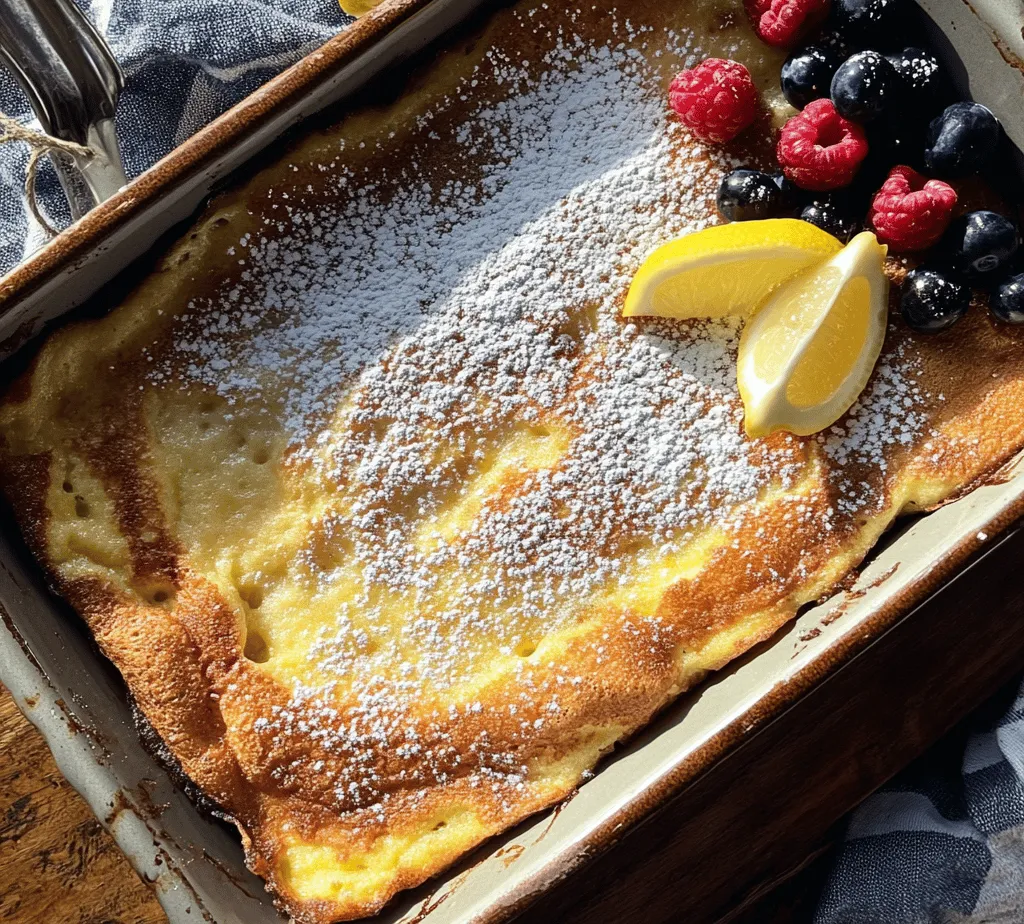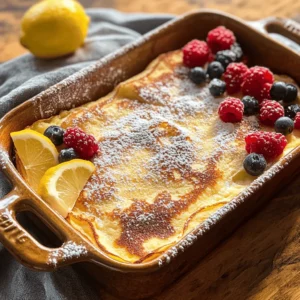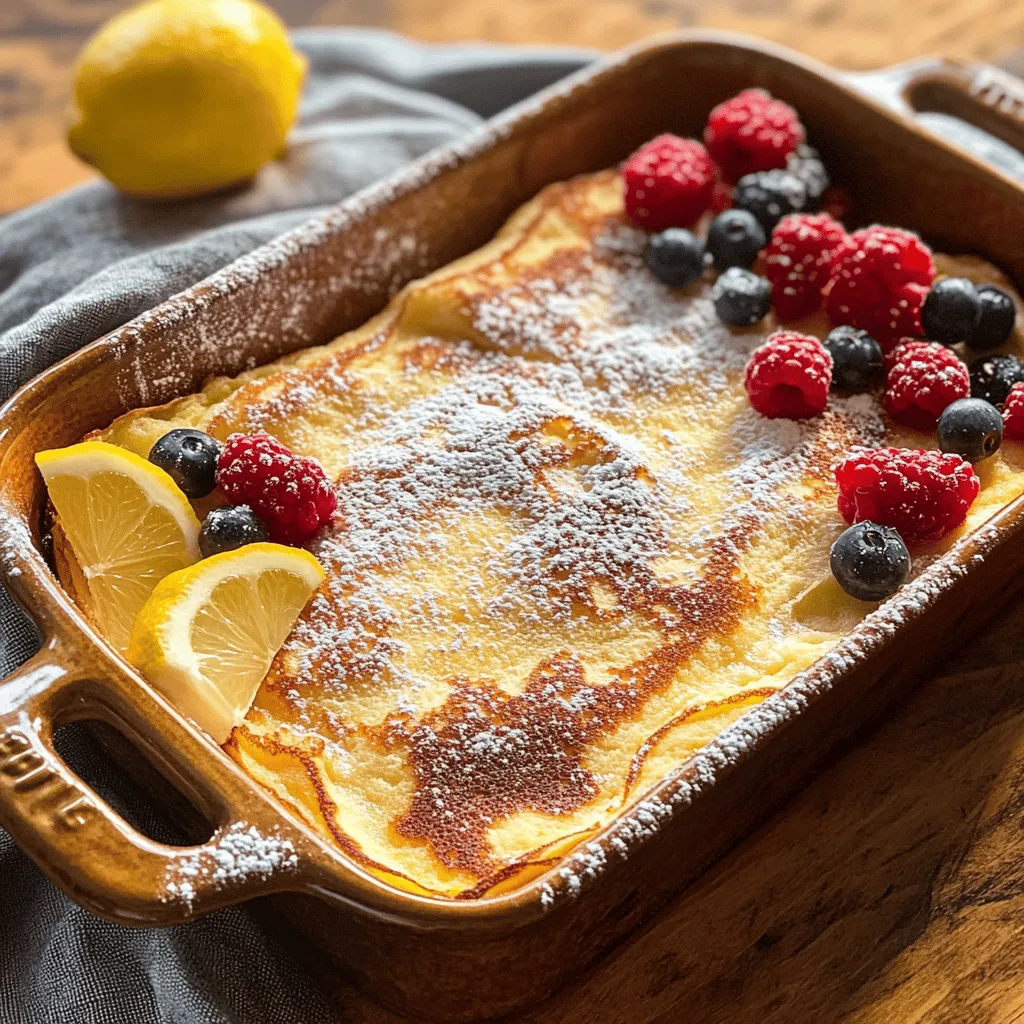Introduction to Fluffy Baked German Pancake
The Fluffy Baked German Pancake is a delightful dish that has captured the hearts of breakfast lovers around the world. Known for its airy, soufflé-like texture and beautifully golden edges, this pancake is both visually stunning and deliciously satisfying. Unlike its traditional American counterpart, which is often served in individual portions and cooked on a stovetop, the German pancake is baked in a single dish, allowing it to puff up dramatically in the oven. This unique cooking method creates a light and fluffy pancake that is perfect for sharing at brunch or a cozy breakfast at home.
What makes the Fluffy Baked German Pancake particularly appealing is its simplicity and versatility. With just a handful of ingredients, you can whip up this impressive dish in no time. It’s perfect for lazy Sunday mornings or special occasions when you want to impress your family and friends without spending hours in the kitchen. Plus, it can be dressed up with a variety of toppings, making it adaptable to different tastes and preferences.
In this article, we will explore the essential ingredients that contribute to the pancake’s fluffiness and flavor, delve into the history of German pancakes, and provide a step-by-step preparation guide to help you achieve the perfect bake.
Understanding the Fluffy Baked German Pancake
To fully appreciate the Fluffy Baked German Pancake, it’s important to understand its origins and how it differs from traditional American pancakes. The German pancake, also known as a Dutch baby, is believed to have originated in the United States in the early 1900s, despite its name suggesting a European lineage. This dish was inspired by the German “Apfelpfannkuchen,” a type of apple pancake. Over time, it evolved into what we now know as the German pancake, characterized by its large, puffy shape and custard-like interior.
One of the key differences between German pancakes and traditional American pancakes lies in their preparation and texture. While American pancakes are made from a thick batter and cooked on a skillet, German pancakes rely on a thinner batter that is poured into a hot, buttered baking dish and baked. This method allows for the batter to rise dramatically in the oven, creating a fluffy and airy texture that is both unique and satisfying. The result is a pancake that is light and tender, often served with a dusting of powdered sugar or a squeeze of fresh lemon juice.
The science behind the fluffiness of the Fluffy Baked German Pancake can be attributed to its key ingredients: eggs, milk, and the technique used during baking. Eggs play a crucial role in providing structure while also incorporating air into the batter when whisked, leading to that trademark puffiness. Milk adds moisture and richness, contributing to the pancake’s overall flavor and texture. The combination of these ingredients, along with the right baking techniques, ensures that your German pancake rises beautifully and delivers a light, airy experience with every bite.
Essential Ingredients for the Perfect German Pancake
To create a Fluffy Baked German Pancake that is not just good but exceptional, it’s essential to understand the role of each ingredient. Here’s a detailed look at the components that work together to produce this delectable dish:
Eggs
Fresh eggs are the cornerstone of any good pancake, and they are especially important in a Fluffy Baked German Pancake. Eggs provide structure and stability to the batter, but more importantly, they incorporate air when whisked. This air is what causes the pancake to rise dramatically in the oven, resulting in the signature fluffy texture. For the best results, use large, fresh eggs. The freshness of the eggs can greatly affect both the flavor and the texture of the pancake.
Milk
Milk is another vital ingredient that impacts the overall texture and taste of the pancake. It adds moisture, which is essential for creating a rich and tender batter. The fat content in the milk also contributes to the pancake’s overall richness. You can use whole milk for a creamier texture or opt for 2% if you prefer a lighter version. In some variations, buttermilk can also be used to enhance the flavor further.
All-Purpose Flour
All-purpose flour is the base of the pancake batter and plays a crucial role in its consistency. It provides the necessary structure to hold the pancake together while allowing it to rise. When measuring flour, be sure to spoon it into your measuring cup and level it off with a knife for accuracy. This prevents adding too much flour, which could result in a dense pancake.
Granulated Sugar
While sugar is not the main feature of the pancake, it plays an essential role in balancing flavors and aiding in browning. A small amount of granulated sugar enhances the taste of the pancake, making it slightly sweet without overpowering other flavors. Additionally, sugar contributes to the caramelization process when the pancake bakes, giving it a beautiful golden-brown color.
Vanilla Extract
Vanilla extract is a simple yet effective way to elevate the flavor of your Fluffy Baked German Pancake. Just a teaspoon or two can enhance the overall taste, providing a warm, aromatic quality that complements the other ingredients. Always choose pure vanilla extract for the best flavor; imitation vanilla can alter the intended taste.
Salt
Salt may seem like a minor ingredient, but it is crucial for balancing flavors in any dish. In the context of a Fluffy Baked German Pancake, salt enhances the sweetness of the sugar and the richness of the eggs and milk, creating a well-rounded flavor profile. A pinch of salt goes a long way in making the pancake taste more vibrant and delicious.
Unsalted Butter
Unsalted butter is key to achieving a rich flavor while preventing the pancake from sticking to the baking dish. The butter is melted and poured into the dish before adding the batter, which not only helps with sticking but also contributes to the pancake’s overall richness. Using unsalted butter allows you to control the amount of salt in the recipe.
Optional Toppings
The beauty of the Fluffy Baked German Pancake lies in its versatility, especially when it comes to toppings. While it’s delicious on its own, you can enhance the presentation and flavor with a variety of toppings. Popular options include a dusting of powdered sugar, fresh lemon wedges for a zesty kick, or a medley of berries such as blueberries, strawberries, or raspberries. These toppings not only add flavor but also provide visual appeal, making your pancake a stunning centerpiece for any breakfast table.
Step-by-Step Preparation Guide
Now that we’ve covered the essential ingredients, let’s dive into the step-by-step preparation process for creating your very own Fluffy Baked German Pancake. The first step is preheating your oven and preparing your baking dish, which is crucial for achieving that magnificent puff.
Preheating and Preparing the Baking Dish
1. Preheat the Oven: Start by preheating your oven to 425°F (220°C). This high temperature is key to creating the pancake’s signature rise and fluffy texture.
2. Prepare the Baking Dish: While the oven is heating, take a 9×13-inch baking dish or a cast-iron skillet and place it in the oven to warm up. Once the oven is preheated, carefully remove the dish (it will be hot!) and add about 4 tablespoons of unsalted butter. The butter will melt quickly, coating the bottom of the dish and creating a non-stick surface for your pancake.
3. Swirl the Butter: Gently swirl the dish to ensure the melted butter covers the entire bottom. This will help prevent sticking and enhance the flavor of the pancake.
By following these initial steps, you set the stage for a perfectly fluffy baked German pancake. The next part of the recipe will guide you through mixing the ingredients and baking the pancake to achieve that delightful puffiness. Stay tuned for the continuation, where we will cover the mixing process and baking instructions!

Importance of a Preheated Dish for the Perfect Rise
To achieve the signature fluffy rise of a baked German pancake, preheating your baking dish is essential. When you pour the batter into a hot dish, immediate contact with the high temperature causes the batter to puff up rapidly, resulting in a light and airy texture. For optimal results, choose a cast-iron skillet or a glass baking dish. Both conduct heat well, but the skillet often provides a beautiful golden crust. Preheat your oven along with the dish for about 10-15 minutes to ensure it reaches the desired temperature before adding your mixture.
Mixing the Batter
Creating the batter for your fluffy baked German pancake is a straightforward yet crucial step. Start by gathering your ingredients: eggs, milk, flour, sugar, salt, and melted butter. It’s best to use room temperature eggs and milk, as this helps with better mixing and a smoother texture.
In a large mixing bowl, whisk the eggs until they are light and frothy. This process introduces air into the mixture, which is vital for the pancake’s fluffiness. Slowly add the milk, whisking continuously, then incorporate the flour, sugar, and salt.
Techniques for Whisking and Ensuring a Smooth Batter
For a perfectly smooth batter, use a whisk or an electric mixer on low speed. Gradually mix in the dry ingredients to avoid lumps. Overmixing can lead to a denser pancake, so aim for just combined ingredients. A few small lumps are acceptable; they will usually disappear during baking.
If you prefer an even silkier texture, you can also strain the batter through a fine mesh sieve before pouring it into the preheated dish. This extra step will ensure that any lumps are removed and that your pancake is as fluffy as possible.
Pouring the Batter into the Hot Dish
Once your batter is ready, it’s time to pour it into the hot baking dish. Carefully remove the preheated dish from the oven, using oven mitts to protect your hands from the heat. Pour the batter directly into the center of the dish. As you do this, the batter should sizzle slightly upon contact—this is a good sign!
Tips for Maintaining Fluffiness During This Step
To maintain the fluffiness during this step, avoid spreading the batter around in the dish. Pouring directly into the center allows the batter to spread out evenly on its own. Additionally, be quick in this process; the longer the batter sits before baking, the less fluffy it will become.
Baking to Perfection
Place the dish back into the oven and bake your German pancake for 20-25 minutes. Resist the urge to open the oven door during the first 15 minutes of baking, as this can cause the pancake to deflate.
Signs to Look For When the Pancake Is Done
You’ll know your pancake is done when it has puffed up dramatically and is golden brown around the edges. The center should look set and slightly jiggly, but not wet. A toothpick inserted into the center should come out clean or with just a few moist crumbs, indicating that it’s ready to be removed from the oven.
Addressing Common Concerns About Deflation
It’s common to worry about deflation after removing the pancake from the oven, as it will naturally settle a bit. This is normal and part of the charm of a baked German pancake. To minimize this, ensure that your batter was well-aerated and that you didn’t open the oven prematurely. If it does deflate, don’t be discouraged; it will still taste delicious!
Serving Suggestions for Fluffy Baked German Pancake
Presentation Ideas for a Delightful Brunch Experience
When it comes to serving your fluffy baked German pancake, presentation is key. Dust the top with powdered sugar for a touch of sweetness and an elegant look. You can slice it into wedges and serve directly from the skillet or transfer it to a large serving platter.
Pairing Suggestions with Beverages
Pair your pancake with a variety of beverages for a well-rounded brunch experience. A steaming cup of coffee or espresso complements the flavors beautifully, while a refreshing herbal tea can provide a lighter touch. For a more festive feel, consider serving with fresh-squeezed orange juice or a fruit-infused sparkling water.
Variations to the Dish: Adding Fruits, Spices, or Syrups
Feel free to get creative with your pancake! Top it with fresh seasonal fruits like berries, bananas, or peaches for a burst of flavor. You can also sprinkle cinnamon or nutmeg into the batter for a warm spice note. Drizzle with maple syrup, honey, or even a homemade fruit compote for added sweetness. You can also add chocolate chips or nuts into the batter for a delightful twist.
Nutritional Information and Benefits
Analysis of the Nutritional Content Per Serving
Each serving of a fluffy baked German pancake offers a balance of macronutrients. Typically, one slice contains around 200-250 calories, depending on the ingredients used. The pancake is rich in protein due to the eggs, providing about 7-8 grams per serving, as well as carbohydrates from the flour, and healthy fats from the butter.
Benefits of Ingredients Used
The ingredients in this dish provide various health benefits. Eggs are a fantastic source of protein and contain essential vitamins such as B12 and D. Milk contributes calcium for strong bones, while flour provides energy-boosting carbohydrates. The addition of fruits as toppings can increase fiber intake and provide essential vitamins.
Discussion on Portion Sizes and Serving Suggestions for Various Dietary Needs
When serving fluffy baked German pancakes, portion sizes can vary based on dietary needs. For a lighter meal, serve smaller slices alongside a fruit salad or yogurt. Those with higher energy needs, such as active individuals or teenagers, may enjoy larger portions. This dish can easily be adapted to fit vegetarian diets, and gluten-free variations can be achieved by substituting regular flour with almond or coconut flour.
Conclusion: Embracing the Fluffy Baked German Pancake in Your Kitchen
Making a fluffy baked German pancake is not just about creating a meal; it’s about indulging in a delightful experience that brings family and friends together. Recapping the ease and joy of this recipe, it’s clear that with a few simple ingredients and techniques, you can produce a dish that’s as visually stunning as it is delicious.
I encourage you to experiment with different toppings and flavors, making this pancake your own. From brunch gatherings to cozy family breakfasts, the German pancake has a timeless quality that will continue to enrich kitchens around the world. So gather your ingredients, preheat that dish, and enjoy all the fluffy deliciousness that awaits you.



